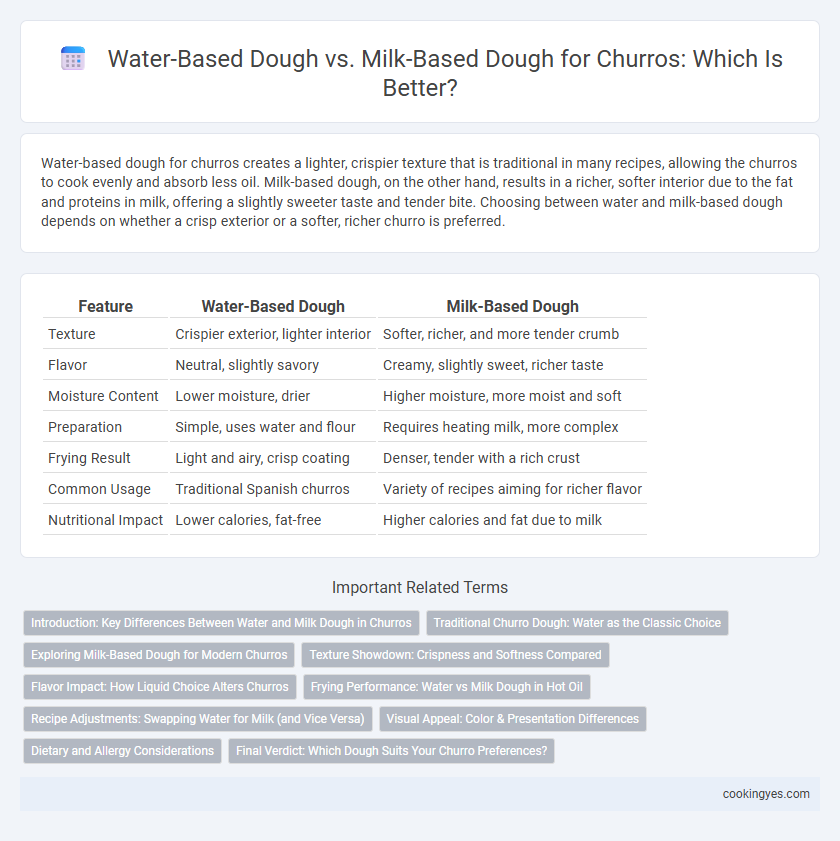Water-based dough for churros creates a lighter, crispier texture that is traditional in many recipes, allowing the churros to cook evenly and absorb less oil. Milk-based dough, on the other hand, results in a richer, softer interior due to the fat and proteins in milk, offering a slightly sweeter taste and tender bite. Choosing between water and milk-based dough depends on whether a crisp exterior or a softer, richer churro is preferred.
Table of Comparison
| Feature | Water-Based Dough | Milk-Based Dough |
|---|---|---|
| Texture | Crispier exterior, lighter interior | Softer, richer, and more tender crumb |
| Flavor | Neutral, slightly savory | Creamy, slightly sweet, richer taste |
| Moisture Content | Lower moisture, drier | Higher moisture, more moist and soft |
| Preparation | Simple, uses water and flour | Requires heating milk, more complex |
| Frying Result | Light and airy, crisp coating | Denser, tender with a rich crust |
| Common Usage | Traditional Spanish churros | Variety of recipes aiming for richer flavor |
| Nutritional Impact | Lower calories, fat-free | Higher calories and fat due to milk |
Introduction: Key Differences Between Water and Milk Dough in Churros
Water-based dough in churros results in a lighter, crispier texture with a distinctively airy interior, while milk-based dough produces a richer, softer bite and a slightly denser crumb due to the fat and proteins in milk. The water dough relies on steam for puffiness, creating traditional thin, crunchy churros, whereas milk dough enhances browning and flavor complexity through Maillard reactions. Understanding these differences helps optimize churro recipes for desired texture and taste preferences.
Traditional Churro Dough: Water as the Classic Choice
Traditional churro dough relies on water as the classic choice, creating a light and crispy texture essential to authentic churros. Water-based dough allows for quick frying and results in a hollow interior that enhances the churro's crunchy exterior. Using water instead of milk maintains the signature crispness and prevents excess greasiness, preserving the traditional flavor and mouthfeel.
Exploring Milk-Based Dough for Modern Churros
Milk-based dough for churros offers a richer, creamier texture compared to traditional water-based dough, enhancing flavor complexity and moisture retention. The proteins and fats in milk contribute to a tender crumb and golden crust, making churros softer inside while maintaining a crispy exterior. Modern recipes utilizing milk-based dough prioritize balanced hydration and fat content to achieve consistent dough elasticity and optimal frying performance.
Texture Showdown: Crispness and Softness Compared
Water-based dough in churros yields a lighter, crisper exterior with a pronounced crunch, ideal for those seeking a traditional texture. Milk-based dough introduces a slight richness and moisture, resulting in a softer, more tender interior while maintaining a delicate crispness on the outside. The choice between water-based and milk-based dough ultimately affects the balance between crispness and softness, tailoring the churro's mouthfeel for different preferences.
Flavor Impact: How Liquid Choice Alters Churros
Water-based dough yields churros with a light, crispy texture and a subtle, neutral flavor that allows toppings like cinnamon sugar to stand out. Milk-based dough imparts a richer, creamier taste and slightly denser crumb due to the milk's fat and proteins. The choice of liquid directly influences the churro's moisture, mouthfeel, and overall flavor profile, making it a key factor in recipe customization.
Frying Performance: Water vs Milk Dough in Hot Oil
Water-based dough for churros tends to produce a lighter, crispier texture due to lower fat content, allowing for faster heat transfer during frying, which results in a golden, crunchy exterior. Milk-based dough contains fats and proteins that create a richer flavor and a denser crumb but can lead to slower frying times and a slightly oilier finish. Frying performance favors water dough for achieving traditional crispiness and reduced oil absorption, while milk dough enhances flavor complexity at the expense of frying speed and texture lightness.
Recipe Adjustments: Swapping Water for Milk (and Vice Versa)
Swapping water for milk in churro dough increases richness and tenderness due to milk's fat and sugar content, requiring reduced butter or sugar to maintain dough balance. Milk-based dough demands lower cooking temperatures and shorter frying times to prevent burning and achieve a golden crust. Conversely, substituting milk with water results in a crisper, lighter texture, but may require added fats or eggs to compensate for moisture and flavor loss.
Visual Appeal: Color & Presentation Differences
Water-based dough for churros typically results in a lighter, crisper texture with a golden-brown color that enhances visual appeal through a classic, airy presentation. Milk-based dough produces a richer, slightly darker hue with a moist, tender crumb, lending a more decadent and glossy finish. These color and texture differences influence consumer perception, with water-based churros often perceived as traditional and crunchy, while milk-based variants appear indulgent and soft.
Dietary and Allergy Considerations
Water-based dough for churros is typically lower in fat and calories, making it a suitable option for those with dairy allergies or lactose intolerance. Milk-based dough contains dairy proteins and fats that can pose risks for individuals with milk allergies or sensitivities. Choosing water-based dough can accommodate vegan diets and reduce allergen exposure without compromising the traditional churro texture.
Final Verdict: Which Dough Suits Your Churro Preferences?
Water-based dough produces lighter, crispier churros with a delicate texture, ideal for those who prefer a crunchy exterior and airy inside. Milk-based dough yields richer, softer churros with a slightly denser crumb, offering a creamy flavor that complements sweet coatings. Your churro preference depends on whether you prioritize a traditional crisp or a more indulgent, tender bite.
Water-based dough vs milk-based dough for churros Infographic

 cookingyes.com
cookingyes.com